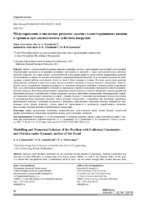| dc.contributor.author | Лукашевич, А. А. | |
| dc.contributor.author | Лукашевич, Н. К. | |
| dc.contributor.author | Островская, Н. В. | |
| dc.coverage.spatial | Минск | ru |
| dc.date.accessioned | 2021-02-04T07:41:35Z | |
| dc.date.available | 2021-02-04T07:41:35Z | |
| dc.date.issued | 2021 | |
| dc.identifier.citation | Лукашевич, А. А. Моделирование и численное решение задачи с односторонними связями и трением при динамическом действии нагрузки = Modelling and Numerical Solution of the Problem with Unilateral Constraints and Friction under Dynamic Action of the Load / А. А. Лукашевич, Н. К. Лукашевич, Н. В. Островская // Наука и техника. – 2021. – № 1. – С. 16-25. | ru |
| dc.identifier.uri | https://rep.bntu.by/handle/data/85421 | |
| dc.description.abstract | Задачи с односторонними связями нередки в практике расчетов строительных конструкций и сооружений. Определенные трудности в их решении возникают при трении на контакте, а также при динамическом действии нагрузки. Известно, что такие задачи с математической точки зрения являются недостаточно корректными, решение их усложняется и зависит от истории нагружения и деформирования конструкции. В то же время возможность учета сложных условий работы конструкции делает ее расчет более полным и точным. В статье рассмотрено решение динамической контактной задачи на основе метода конечных элементов и метода шагового нагружения. Односторонние связи с кулоновским трением моделируются с помощью контактных конечных элементов рамно-стержневого типа. Для соблюдения ограничений в условиях по предельному трению-скольжению применяется способ компенсирующих нагрузок. На основе рассмотренной дискретной модели контакта и метода пошагового анализа разработан численный алгоритм, позволяющий в одном пошаговом процессе выполнять одновременно интегрирование уравнений движения и реализацию контактных условий с трением Кулона. С помощью предложенного подхода получены и проанализированы численные решения задачи контакта сооружения с основанием при различных параметрах динамической нагрузки. Сравнение результатов с решением, выполненным известным методом итераций по предельным силам трения, позволяет сделать вывод об эффективности и надежности разработанного алгоритма при сложных условиях контакта и динамическом нагружении. | ru |
| dc.language.iso | ru | ru |
| dc.publisher | БНТУ | ru |
| dc.title | Моделирование и численное решение задачи с односторонними связями и трением при динамическом действии нагрузки | ru |
| dc.title.alternative | Modelling and Numerical Solution of the Problem with Unilateral Constraints and Friction under Dynamic Action of the Load | ru |
| dc.type | Article | ru |
| dc.identifier.doi | 10.21122/2227-1031-2021-20-1-16-25 | |
| local.description.annotation | Problems with unilateral constraints are not uncommon in the practice of calculating building construction and structures. Certain difficulties in solving them arise during contact friction, as well as the dynamic action of the load. It is known that such problems from a mathematical point of view s are not correct enough, their solution becomes more complicated and depends on the history of loading and deformation of the structure. At the same time, the ability to take into account the complex working conditions of the structure makes its calculation more complete and accurate. The paper considers the solution of a dynamic contact problem on the basis of the finite element method and the step-by-step loading method. Unilateral constraints with Coulomb friction are modeled using contact finite elements of a frame-rod type. The method of compensating loads is applied in order to comply with the limitations under ultimate friction-sliding conditions. Based on the considered discrete contact model and the step-by-step analysis method, a numerical algorithm has been developed, which allows in one step-by-step process to integrate simultaneously the equations of motion and implement contact conditions with Coulomb friction. With the help of the proposed approach, numerical solutions of the problem pertaining to a structure contact with the base have been obtained and analyzed at various parameters of dynamic load. Comparison of the results with the solution obtained by the well-known iteration method on the ultimate friction forces allows to conclude about the efficiency and reliability of the developed algorithm under complex contact conditions and dynamic loading. | ru |

